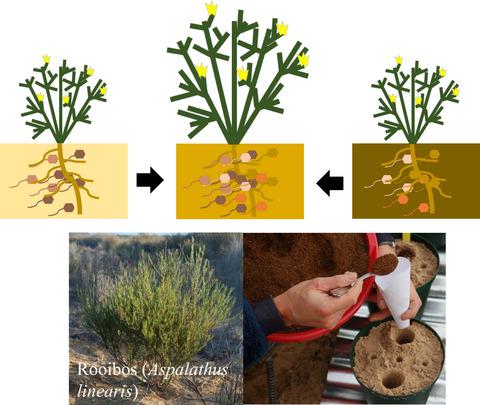当前位置:
X-MOL 学术
›
J. Appl. Ecol.
›
论文详情
Our official English website, www.x-mol.net, welcomes your
feedback! (Note: you will need to create a separate account there.)
Soil microbial community coalescence and fertilization interact to drive the functioning of the legume–rhizobium symbiosis
Journal of Applied Ecology ( IF 5.0 ) Pub Date : 2021-08-18 , DOI: 10.1111/1365-2664.13995 Josep Ramoneda 1, 2 , Johannes Le Roux 3 , Stefanie Stadelmann 1 , Emmanuel Frossard 1 , Beat Frey 4 , Hannes Andres Gamper 1, 5
中文翻译:

土壤微生物群落聚结和施肥相互作用以驱动豆科植物-根瘤菌共生的功能
更新日期:2021-08-18
Journal of Applied Ecology ( IF 5.0 ) Pub Date : 2021-08-18 , DOI: 10.1111/1365-2664.13995 Josep Ramoneda 1, 2 , Johannes Le Roux 3 , Stefanie Stadelmann 1 , Emmanuel Frossard 1 , Beat Frey 4 , Hannes Andres Gamper 1, 5
Affiliation

|
- Soil microbial community coalescence, where entire microbial communities mix and interact under new conditions, is a widespread phenomenon whose applicability for targeted root microbiome assembly has not been studied. Whether soil mixing can lead to predictable outcomes for community assembly and functioning of specific functional groups, for example, N2-fixing rhizobia, remains unknown.
- Using a legume shrub adapted to nutrient-poor soils, we tested the effects of community coalescence on plant nutrition and growth, and its influence on the rhizobial root nodule symbiosis. We grew seedlings of rooibos [Aspalathus linearis (Burm.f.) Dahlg.] in individual rhizosphere soils collected from cultivated and wild rooibos plants and their mixtures, and included a fertilization treatment. Portions of the taxonomic gyrB and the symbiotic nodA gene makers were sequenced to characterize rhizobial communities present in rooibos root nodules under the different soil conditions.
- Overall, community coalescence by soil mixing had positive effects on plant nutrition and growth, and interacted with fertilizer addition to concurrently change rhizobial taxonomic evenness and promote higher relative N2 fixation. We identified particular rhizobia preferentially associated with rooibos plants that showed higher N fractions from N2 fixation, raised in mixed fertilized soils.
- These findings indicate that soil bacterial community coalescence and fertilization can have synergistic effects on plant performance, while promoting the assembly of alternative symbiotic rhizobial communities that provide improved nutritional benefits to host plants.
- Synthesis and applications. The combination of soil mixing and fertilizer addition may be an important, but hitherto overlooked measure to improve the functioning of rhizobium symbioses in legume crops. Microbial community coalescence should gain recognition as a potentially effective mechanism to improve the functioning of plant microbiomes.
中文翻译:

土壤微生物群落聚结和施肥相互作用以驱动豆科植物-根瘤菌共生的功能
- 土壤微生物群落聚结,即整个微生物群落在新条件下混合和相互作用,是一种普遍现象,其对靶向根微生物组组装的适用性尚未得到研究。土壤混合是否可导致预测的结果对社区组件和特定官能团的功能,例如,N 2 -定影根瘤菌,仍然是未知的。
- 使用适应贫瘠土壤的豆科灌木,我们测试了群落聚结对植物营养和生长的影响,及其对根瘤菌根瘤共生的影响。我们在从栽培和野生路易波士植物及其混合物中收集的单个根际土壤中种植了路易波士[ Aspalathus linearis (Burm.f.) Dahlg.] 的幼苗,并进行了施肥处理。对分类学gyrB和共生nodA基因标记的部分进行测序,以表征不同土壤条件下路易波士根瘤中存在的根瘤菌群落。
- 总体而言,土壤混合引起的群落聚结对植物营养和生长具有积极影响,并与施肥相互作用,同时改变根瘤菌分类均匀度并促进较高的相对 N 2固定。我们确定了优先与路易波士植物相关的特定根瘤菌,这些植物在混合施肥的土壤中生长,其N 2固定显示出更高的 N 分数。
- 这些发现表明,土壤细菌群落合并和施肥可以对植物性能产生协同作用,同时促进替代共生根瘤菌群落的组装,为寄主植物提供更好的营养益处。
- 合成与应用。土壤混合和肥料添加的组合可能是一个重要但迄今为止被忽视的措施,以改善豆科作物中根瘤菌共生的功能。微生物群落聚结应该被认为是改善植物微生物组功能的潜在有效机制。











































 京公网安备 11010802027423号
京公网安备 11010802027423号